Related Research Articles
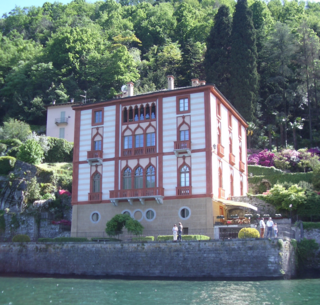
Villa Plinianina is a patrician rural palace on the shores of Lake Como, located in the comune of Torno, Province of Como, region of Lombardy, Italy.

The Certosa di Pavia is a monastery and complex in Lombardy, Northern Italy, situated near a small town of the same name in the Province of Pavia, 8 km (5.0 mi) north of Pavia. Built in 1396–1495, it was once located on the border of a large hunting park belonging to the Visconti family of Milan, of which today only scattered parts remain. It is one of the largest monasteries in Italy.

The Villa Cicogna Mozzoni is a rural patrician residence in Bisuschio, near Varese, Province of Varese, region of Lombardy, Italy. It is an example of Lombard Renaissance architecture.

The Royal Villa is a historical building in Monza, northern Italy. It lies on the banks of the Lambro river, surrounded by the large Monza Park, one of the largest enclosed parks in Europe.

The Portinari Chapel is a Renaissance chapel at the Basilica of Sant'Eustorgio, Milan, northern Italy. Commenced in 1460 and completed in 1468, it was commissioned by Pigello Portinari as a private sepulchre and to house a silver shrine given by Archbishop Giovanni Visconti in 1340 containing the relic head of St. Peter of Verona, to whom the chapel is consecrated. The architect is unknown, the traditional attribution to Michelozzo having been succeeded with equal uncertainty by attributions to either Filarete or Guiniforte Solari, architect of the apses of the Certosa di Pavia and the church of San Pietro in Gessate in Milan.
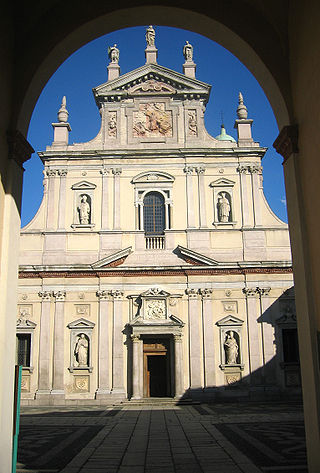
Garegnano Charterhouse, also known as Milan Charterhouse is a former Carthusian monastery, or charterhouse, located on the outskirts of Milan, Italy, in the Garegnano district. It now houses a community of Capuchin Friars.

Palazzo Marino is a 16th-century palace located in Piazza della Scala, in the centre of Milan, Italy. It has been Milan's city hall since 9 September 1861. It borders on Piazza San Fedele, Piazza della Scala, Via Case Rotte and Via Tommaso Marino.

Soncino Castle is a military fortress in Soncino, northern Italy. It was built in the 10th century, and it was active since the years around 1500.
The Villa Arconati, also known as the Castellazzo Degli Arconati, is a rural palace and gardens, located in the district of Castellazo of the town of Bollate, northwest of Milan, Italy. Built-in a grand Baroque style over the 17th and 18th centuries, it now functions as a museum and host for events and meetings.
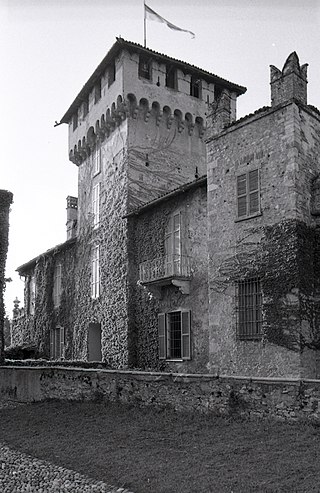
The Visconti Castle of Somma Lombardo is a medieval castle-palace in Somma Lombardo, Province of Varese, Lombardy, northern Italy.

The Villa Sola-Busca, also called Villa La Quieta, is a Neoclassical style rural palace outside of the town of Tremezzo, on the shores of Lake Como in the Region of Lombardy, Italy.

The Villa Gallarati Scotti is a rural palace located near the town of Vimercate, in the Province of Monza and Brianza, in the Region of Lombardy, Italy.
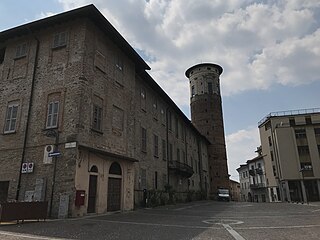
The Palazzo Prinetti is a palace located in the town of Merate, in the Province of Lecco, in the Region of Lombardy, Italy.
The Villa Scheilbler Gallarati Scotti is a 16th-century hunting lodge and rural palace located in the town of Rho in the province of Milan, Region of Lombardy, Italy. This villa differs from the Villa Gallarati Scotti at Vimercate.
The Palazzo Vertemate-Franchi is best described as a villa due to its rural position in the Valchiavenna in the province of Sondrio in the region of Lombardy, Italy. The nearby original town of Piuro was destroyed during a landslide on August 25, 1618; and the property is administered by the comune of Chiavenna.
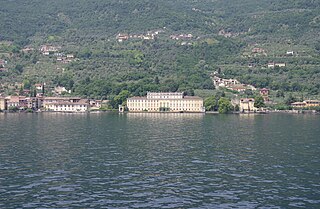
Villa Bettoni is a large lake-side Neoclassical-style rural palace located in the frazione of Bogliaco, on the shores of Lake Garda, within the town limits of Gargnano, Province of Brescia, region of Lombardy, Italy. The villa includes lakefront and gardens.
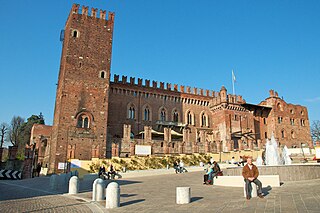
The Castello di Carimate is a 14th-century castle located on Piazza Castello #1 in the town of Carimate, Province of Como, Lombardy, Italy.
The Villa Litta Modignani is a 17th-century rural palace and park located on Via Taccioli in the north suburbs of Milan, in the Province of Milan, Lombardy, Italy.

Santa Maria in Brera was a church in Milan, in Lombardy in northern Italy. It was built by the Humiliati between 1180 and 1229, given a marble façade and Gothic portal by Giovanni di Balduccio in the fourteenth century, and deconsecrated and partly demolished under Napoleonic rule in the early nineteenth century. The Napoleonic rooms of the Pinacoteca di Brera occupy the upper floor of what was the nave.

The church of San Francesco of Assisi is a Catholic religious building in Pavia, Lombardy, Italy.
References
- ↑ Lombardia Beni Culturali entry on the villa.
- ↑ Ville e castelli d'Italia: Lombardia e laghi, second edition, by Luca Beltrami, Editors of Tecnografica, Milan, (1907), page 228.
- ↑ Luca Beltrami, pages 225-226.